
DES-7200 Configuration Guide Chapter 7 DHCPv6 Server Configuration
7-4
configuration information. Each Client can apply for multiple bindings. The binding
data on Server are organized in the form of binding table and indexed by DUID,
IA-Type and IAID.
7.1.2.4 Type of DHCPv6 messages
According to RFC3315, DHCPv6 uses UDP 546 and 547 ports to exchange
messages: the DHCPv6 Client uses Port 546 to receive messages, while the
DHCPv6 Server and Relay will use Port 547 to receive messages. The type of
messages that can be exchanged between DHCPv6 Server, Client and Relay are
shown below (as per RFC3315):
1. Type of messages sent from Client to Server include: Solicit, Request, Confirm,
Renew, Rebind, Release, Decline, Information-request;
2. Type of messages sent from Server to Client include: Advertise, Reply,
Reconfigure;
3. Type of messages sent from Relay to Relay to Server include: Relay-forward;
4. Type of messages sent from Server or Relay to Relay include: Relay-reply;
During message exchange, in order to simplify the exchange flow, not all types of
messages will be used. Instead, flexible control can be realized through the DHCPv6
options carried by messages, and the data transmitted by messages will also change
according to different options. The types and roles of DHCPv6 messages are similar
to that of DHCPv4 messages. Although DHCPv6 messages have made some
changes for the new network and flow, certain types of messages are still related.
The comparison between DHCPv6 messages and DHCPv4 messages is shown
below:
DHCPv6 messages DHCPv4 messages
Solicit (1) DHCPDISCOVER
Advertise (2) DHCPOFFER
Request (3), Renew (5), Rebind (6) DHCPREQUEST
Reply (7) DHCPACK / DHCPNAK
Release (8) DHCPRELEASE
Information-request (11) DHCPINFORM
Decline (9) DHCPDECLINE
Confirm (4) NA
Reconfigure (10) DHCPFORCERENEW


















